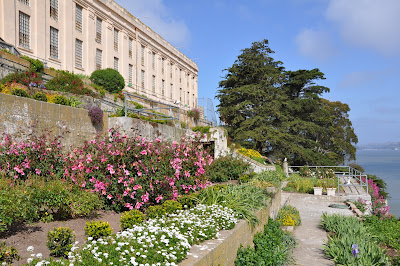Spain, a land of brilliant sunshine and landscapes that manifest the country's rich history.
My journey began in Barcelona, moved south to Granada, and braided together a side trip to Valencia: A coastal destination with stunning contemporary gardens, Valencia will surface in future postings where I'll share my discoveries and not-to-miss sites in a city bursting with energy.
For now, if it's a bit of paradise you're after.... Granada holds sway in a little-known garden secreted from the throngs that stream through the corridors of the Alhambra.
Ramble down the road, away from the cacophony of tourist buses unloading at that magnificent monument. Along the narrow, winding streets to the Alhambra Palace Hotel esplanade, follow the marker pointing toward the Rodriguez-Acosta Foundation, its inconspicuous, worn wooded doorway set within a formidable streetside wall.
Sequestered here is the early 20th century home and studio of Granada-born painter Jose Maria Rodriguez-Acosta; now a museum, cultural hub, and beautifully preserved gardens. There's a calculated momentum to this journey. You must proceed through a passageway of the foundation building, before crossing a threshold to behold the artist's modernist landscape - a multilevel configuration of individuated garden rooms presided over by classical statuary.
Borrowing features from the rarified atmosphere of a Roman temple, the artist set the stage to stir intellectual and utopian yearnings with an architecture of clean-lined spaces defined by columned arcades and emerald green partitions - the garden's long-established clipped cypress hedges.
A tour of the garden unfolds along glistening stone terraces open to the bright cerulean sky, and in stark contrast, through shady vestibules enlivened by a play of light and shadow cast by the towering columns and rounded arches. By way of staircases linking the terraces, you move through a framework of hedges of varying heights, which organize the garden's soothing geometry. The outside world disappears amid these hedges that enclose and conceal unexpected scenarios.
Around each corner a discreet scene turns your attention to a draped goddess, naked god, or a gathering of cherubs balanced on high pedestals: Enchanting prospects complemented by auditory effects from the splashing jets of a reflecting pool or gurgling fountains.
The restrained theatricality culminates with a spectacular colonnade inset with ironwork balconies. Perched on high at the garden's periphery, a promontory takes full advantage of the site, not far from the Alhambra. Visitors are enticed to linger, looking out over evocative vistas of the countryside and rugged mountains in the distance.
In the coming days, my journey of discovery will continue to unfold, revealing a hidden gem in Barcelona; the Alhambra's Generalife gardens; Valencia's expansive Turia Gardens, too. Santiago Calatrava's spirited design for the City of Arts and Sciences succeeded in putting Valencia 'on the map' so to speak, yet the city holds still more surprises.
.jpg)
.jpg)
.jpg)


















 Paradise on earth.... an idealized world hidden within the walls of the Islamic garden.
Paradise on earth.... an idealized world hidden within the walls of the Islamic garden.